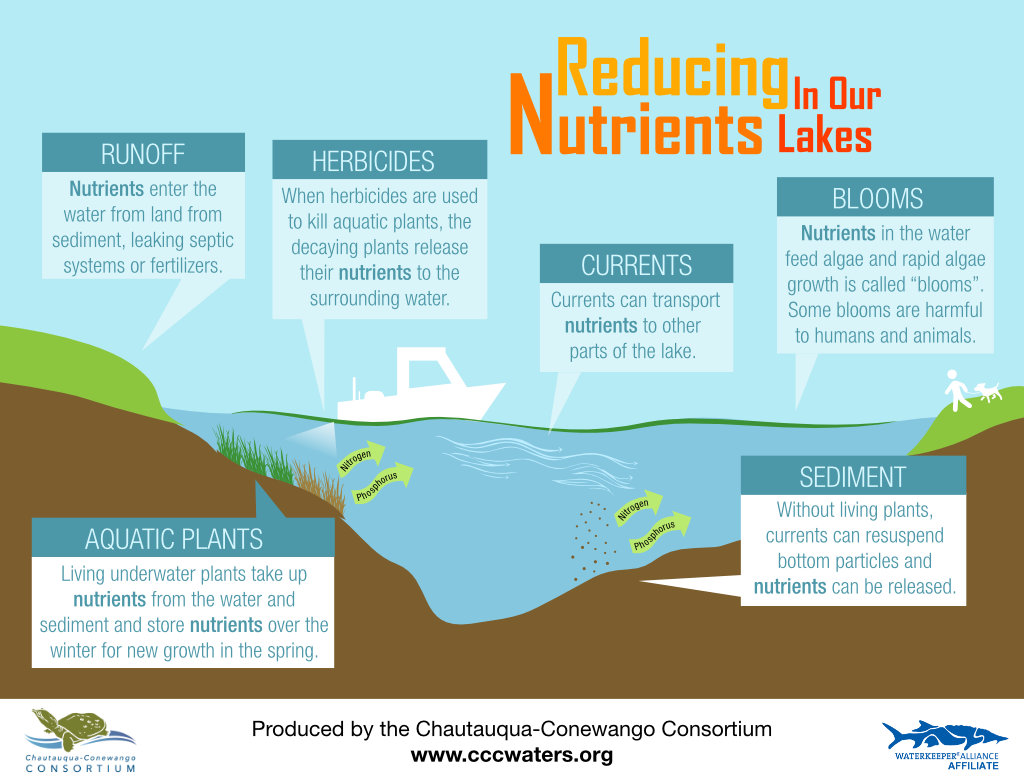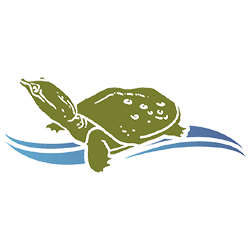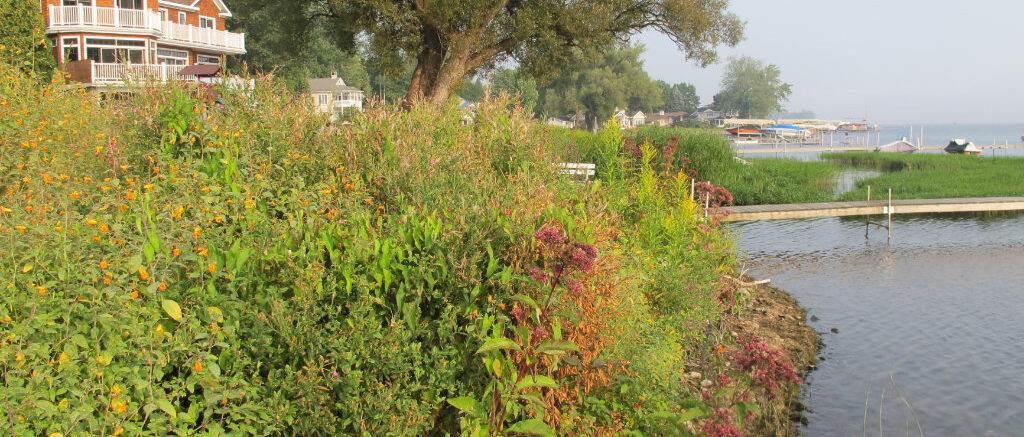The numbered boxes in the diagram below are important components in lake ecosystems. While each identified component can be considered by itself, in nature all of these components interact as an interconnected system. This means that ecosystems are complex and that changes in one part of the system (e.g., increase or decrease in nutrient levels) can impact other parts of the system.
1. Runoff – Nutrients enter the water from land from sediment, leaking septic systems, or fertilizers
Two common nutrients found in aquatic systems are nitrogen (N) and phosphorous (P). Both of these elements are part of complex cycles, which circulate the food needed for growing green plants. However, nutrients on the land need to be kept on the land. Human activity has caused an increase of nutrients on the land and moving water has washed those nutrients into streams and lakes. The excess nutrients in the water then cause the excess growth of algae and plants in the lake.
2. Aquatic plants – Living underwater plants take up nutrients from the water and sediment and store nutrients over the winter for new growth in the spring
Chautauqua Lake contains both native and non-native plant species. The native species include: Coontail, Wild celery, Elodea and many Pondweed species. Two non-native plants, Eurasian watermilfoil and Curly-leaf pondweed, were introduced into the lake decades ago and are considered to be well-established and are part of the lake’s ecosystem. Aquatic plants are valuable as they produce oxygen in the water, provide habitat for fish, stabilize lake bottom sediments, and store nutrients within their roots and tissues.
3. Herbicides – When herbicides are used to kill aquatic plants, the decaying plants release their nutrients to the surrounding water
Living, green submerged plants produce oxygen which becomes dissolved in the water. Fish and underwater insects require that oxygen for survival. Plants treated with herbicides are killed and decay. The decaying process requires dissolved oxygen thus the rapid die-off of herbicide-treated plants can lead to low levels of oxygen. Plus, the dying plants’ can no longer hold their nutrients and they are sent into the water or the sediment.
4. Currents – Currents can transport nutrients to other parts of the lake
Winds blowing over the lake can generate waves as well as currents. The warming of waters during the summer can lead to stratification of the water column, with warmer, less dense water above cooler, more dense water. These two layers remain separated with movement of waters in each layer distinct from each other. In Chautauqua Lake, currents are able to transport water in both directions so that waters from the North Basin can flow into the South Basin and vice versa. Currents can redistribute sediment, nutrients and herbicides introduced into the water column.
5. Sediment – Without living plants, currents can resuspend bottom particles and nutrients can be released
Sediment can be characterized by its composition and by its size. Sediment provides a bottom material, called substrate, for plants to anchor their roots. During high energy storm events, sediment can be moved by waves, currents, and even ice. If there are living plants, their roots can hold the sediment, the substrate, in place. This keeps the water visibly clearer in those areas. Sediments also enter the lake via creeks and in some locations has accumulated around the mouth of tributaries.
6. Blooms – Nutrients in the water feed algae and rapid algae growth is called ‘blooms’. Some blooms are harmful to humans and animals
The occurrence of algal blooms in lakes around the world are increasing and that includes Chautauqua Lake. With climate change comes warmer water temperatures and less ice cover and we can expect the frequency and duration of blooms to increase. We can detect these blooms from space and you can sometimes identify blooms by the bright green color of the water. Some blooms contain commonly called “blue-green algae” (actually cyanobacteria) that can secrete toxins. These toxins are harmful to humans and animals, so these blooms are known as Harmful Algal Blooms or HABs.


